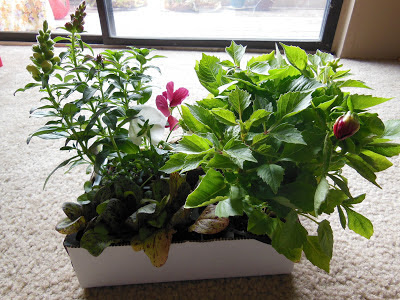Once more, I took a class at
Phelan Gardens. This time it was a Fairy Garden class. My camera died before I could take one picture so I apologize for the bad-ish quality of the photo's. All of the instructional photo's are from my phone and when I got home I took more pictures with my camera.
These are the materials that we used:
- I used a plastic bowl, but you can use any container you want. I've people use broken pots, small wagons or glass bowls, etc. (My next project will be in a broken pot if I can break it how I want!)
- A cup of gravel, the teacher at the class suggested fish tank gravel because it keeps it's color well.
- A cup of sand, if you buy it from a craft store make sure it says it can be used with plants. Some decorative sands can't.
- Soil, we used Fertilome soil. From what I gathered it doesn't have any fertilizers in it. Since this is a garden in such a small container with relatively small plants you don't want fertilizer to encourage fast growth. The idea is to keep things small. This type of soil also will not give you gnat larva! Hooray!!
- Stones, drift wood, marbles, small furniture or whatever else you want to decorate with.
- Small plants. I used hens and chicks, irish moss, creeping jenny, an eugenia bonsai tree, and some other small tree looking things that I never did catch the name of. Click here for a website that has a list of plants you could use that will stay relatively small!

I started with my plastic bowl and filled it to the top with soil.
Then I took my eugenia bonsai tree out of it's pot. We started with the largest plant so that it would be easy to create a focal point. We did not loosten the soil around it's roots because if you leave them a little bound up it will grow slower and will stay smaller longer. As it grows you will probably want to trim it.
I put the tree a little off center because I had planned a tiny camping ground in the middle. I wanted the tree to kind of draw your eye down to the small tent that would later live at the bottom.
I then dug where I wanted my path and camping area to later go. This is just planning ahead for where your gravel will be. Make sure you leave plenty of space around it to put plants.
Here are my plants! That was one thirsty creeping jenny... but it's one of my very favorite plants so I had to take it anyway. In the words of Charlie Brown, I think it needs me.
Then I added some plants. My goal was to create a small forest with an over grown path going through leading to the tent. I planted my tallest plants first and moved down to shortest, I just found this most easiest for me.
Gradually I added more plants, stones, and my drift wood. I also filled my path half way up with sand. I learned that this will help to wick water to all of the plants while watering.
Then I covered my sand with gravel.
This is what it looked like when I got it home! I then got to work on adding things I made or already had. Finally a use for the sea shells I got on my honeymoon in Florida!
I made a tiny tent and a trellis. The trellis, my dachshund prefers most out of anything else to pull out and drag all over the house trying to eat it. She loves to choose a favorite thing about each of my projects to try to eat while I'm taking pictures for my blog. She loves me enough to give me challenges I guess!!
When watering these gardens you will pour the water on the gravel. Certain plants will tell you when to water, like the creeping jenny or the irish moss. They will get very droopy and sad. You will also want to mist everything else with a spray bottle. Also, they will need diffused sun light.
If you have any questions, feel free to comment and I will answer! Thank you for reading!































































